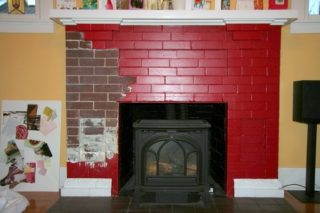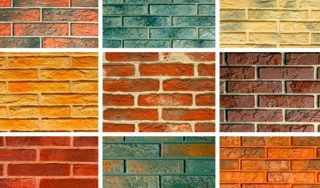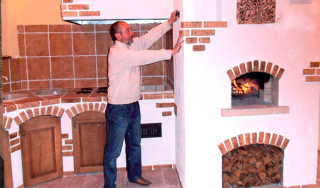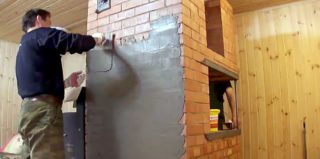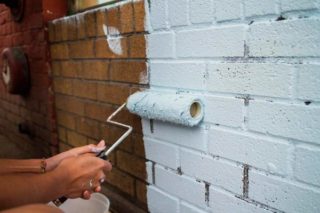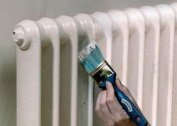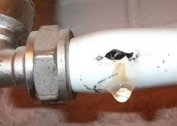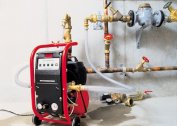A brick stove should organically fit into the interior of a house or cottage. For this reason, it may require painting. There are different types of coloring materials, but not all of them are suitable for coloring a heating device. Before painting a brick stove in a house, you need to find out what paints can be used and what properties they have.
The need for painting
There are several main reasons why people begin to paint Russian stoves in the house and bathhouse.
- Aesthetics. The stove a potbelly stove warms the house and is an element of an interior. The right color will help create coziness in the atmosphere of the home. A beautiful stove can be a real highlight of the room.
- After painting, heat transfer improves, the surface of the furnace becomes more even.
- Protection against fungi and mold. A correctly selected composition will prevent the formation of harmful bacteria on the surface of the brick building.
- Processing with various coloring agents prevents the appearance and increase of cracks.
- Extension of service life. A painted oven will last longer than an unpainted oven by creating a protective coating.
To ensure that all conditions are met, you need to choose the right paint. The functions of the dye also affect the choice of material for painting a brick oven in the house.
Requirements for kiln spraying compounds
A furnace is a device that is complex in terms of operating conditions, so certain conditions are imposed on the choice of paint. The material must be resistant to high temperature. The heating ranges of different parts of the furnace are different, which should also be taken into account. The iron part warms up more, so it needs a more heat-resistant composition.
By the degree of resistance to elevated temperatures, paints for a brick oven can be divided into fireproof, heat-resistant and heat-resistant. The first withstand temperatures up to 1800 ° C. They are expensive and are almost never used in everyday life. Heat-resistant coloring materials withstand 600 ° C - 1000 ° C. It is used to paint iron parts in the stove. For painting the body using special heat-resistant paints that withstand 200-400 ° C.
Also, the coloring composition must meet the following characteristics:
- Safety. When heated, no harmful substances should be released. For this reason, you must definitely familiarize yourself with the composition of the paint before coating the red brick oven with a mixture.
- Thermal conductivity. The composition should not interfere with the heating of the room and reduce the efficiency of the furnace.
- Resistance to household chemicals. Must withstand routine care.
- Elasticity. Temperature jumps should not cause cracks.
There are several varieties of paints for the oven.
Types of Professional Materials
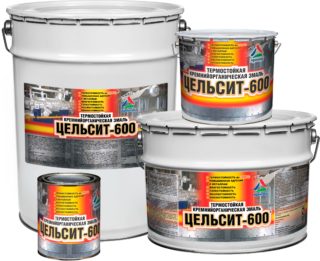 The range of paints and varnishes for furnaces is presented by Russian and foreign manufacturers. You can find paint for any budget with any characteristics. The tool can repaint the stove in a different color or give it a darker or lighter shade.
The range of paints and varnishes for furnaces is presented by Russian and foreign manufacturers. You can find paint for any budget with any characteristics. The tool can repaint the stove in a different color or give it a darker or lighter shade.
Organosilicon Compounds
This type of composition can include various mixtures based on organic resins. It can be paints, varnishes, enamels. Used for exterior decoration and painting of internal elements in the house. The choice of dye and its characteristics is determined by its purpose.
To cover the surface of stoves and fireplaces, heat-resistant organosilicon paints are used. When buying, it is important not to confuse the composition, as moderately heat-resistant solutions are produced with a similar name. They cannot withstand temperatures above + 100 ° C.
The positive features of such mixtures include:
- Good adhesion. Paint is easily applied to any texture.
- High strength.
- The formed shell protects the oven well from moisture.
- Long service life.
- Good heat resistance and elasticity. The paint withstands about 250 cycles of cooling and heating without losing its properties.
The coloring matter has one significant drawback - the limited color palette. This is due to the chemical composition and scope.
For applying enamels and paints, a roller, brush or spray gun is used.
Heat Resistant Acrylic Paints
The group of heat-resistant acrylic paints includes water-based or hydrocarbon-based materials made from acrylates. They are able to withstand temperatures up to 400 ° C depending on the composition. In domestic conditions, it is most often water dispersion paints that are used, although water-based substances can be used.
Alkyd Emulsions
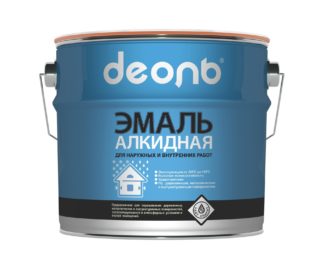 The name of the substance "alkyd" consists of two definitions - alcohol alcohol and acid acid. The composition of the emulsion paint contains alkyd varnish, a coloring substance and a solvent, the role of which is most often played by white spirit. Also, in different types of paints marble and granite dust may be present, as well as additives against fungi, mold, ignition.
The name of the substance "alkyd" consists of two definitions - alcohol alcohol and acid acid. The composition of the emulsion paint contains alkyd varnish, a coloring substance and a solvent, the role of which is most often played by white spirit. Also, in different types of paints marble and granite dust may be present, as well as additives against fungi, mold, ignition.
Alkyd emulsion is used to cover the stove or fireplace. The surface temperature should not exceed 100 ° C - this is the main disadvantage of such funds. At the same time, the color palette is very diverse. It is also important to note the low elasticity of the solution. It does not withstand thermal expansion, which is why in a year small cracks form on the painted surface of the furnace.
Heat resistance is increased by adding aluminum powder to the aqueous emulsion solution. But such compositions are not suitable for painting stoves and fireplaces.
Other types of dyes
In addition to professional mixes, you can paint a brick oven with the following types of coloring agents:
- Oil paint. A specially selected tool for a brick is one of the best options. The main advantages include a wide selection of colors, withstanding temperatures up to 600 ° C, protecting the brick from oxidation and increased resistance. The service life reaches 10 years when working with the furnace. Differs in simplicity of drawing. Among the shortcomings are the smell, the presence of toxic substances and a long drying time.
- Drying oil. The stain gives a darker shade to the brick. It has an unpleasant odor, so it is rarely used.
- Heat-resistant varnish. Improves technical specifications. Dry gouache is added to the varnish to create the desired color and shade.
- Silicate paint. Consists of water glass, in which fillers and pigments are added. It has a high degree of heat resistance.
- Latex formulations. A combination of latex and acrylic is used. The disadvantages include the formation of fungus and mold in the composition.
The choice of product depends on the operating conditions and paint requirements.
DIY painting material
If it is impossible to buy a professional coloring agent, you can independently engage in its manufacture. There are different recipes for creating paint for a brick oven.
- A solution of chalk or lime. To create it, water and lime will be required. They can be bought at a hardware store. The difference in these two types is only in the duration of complete drying. If chalk is used, the waiting time will be longer. The mixture consists of 1 kg of lime or chalk and 1.5 liters of water. For strength, 300 g of salt per 2 kg of the mixture is added to the solution. It turns out the composition is white.The advantages include minimal financial costs, ease of application, glossing over defects and resistance to the formation of fungi. Disadvantages - poor coverage, gets dirty quickly and requires periodic updates.
- Natural varnish. It is made of brick dust, protein of eggs and milk, which are taken in a ratio of 1: 1. To process 1 sq.m. ¼ liter of milk and 8 chicken proteins are required. To prepare the varnish, beaten egg whites and milk are added to the brick dust. They need to be mixed until a thick consistency is formed. Apply varnish with a brush to the heated surface of the brick wall of the stove. The result is a smooth red coating with good resistance to sudden changes in temperature. For dullness, the surface from above is worked out with drying oil. Contact with painted surfaces may leave marks. Also, during operation, the smell of baked milk is emitted.
Hand-made coloring agents only add a touch of color to the brick. To change its color, it is more advisable to use purchased professional paints.
Preparation of the furnace for work
Before painting a brick oven, its surface must be treated. If the product has a new masonry, just clean it from dust.
For cleaning you will need:
- A small spatula. It will allow you to prepare the surface, apply putty and plaster the surface.
- Brush. Allows you to clean the previous coat of paint from bricks and metal parts.
It is necessary to pay attention to the thickness of the plaster layer. If it is more than one centimeter, dismantling will be required. All crumbling areas are removed, the surface is cleaned with a spatula, brush or sandpaper. Cracks must be repaired with gypsum mortar.
When the solution dries, the surface should be wiped with a damp cloth. After the water dries, a coloring agent is applied.
Before using any paint, you must read the instructions. For good interaction, the surface can be pre-impregnated with a primer. Further, everything is done according to the instructions.
Oven painting
You can start painting only after studying the instructions and conducting preparatory work. Otherwise, the efficiency will deteriorate, the service life will be reduced.
To work, you will need:
- Capacity. A coloring solution will be placed in it.
- Paint.
- Brush and roller.
The solution must be prepared and poured into a container. Then it is applied to the surface in several layers (two-layer laying is recommended). Work is carried out by brush and roller. The brush gives texture, and the roller gives uniformity.
After staining, wait until the oven has completely dried. It is forbidden to immediately heat, a minimum of 24 hours must pass, depending on the type of paint.
